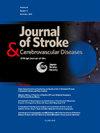机械取栓术患者的病假和伤残抚恤金。
IF 2
4区 医学
Q3 NEUROSCIENCES
Journal of Stroke & Cerebrovascular Diseases
Pub Date : 2025-01-10
DOI:10.1016/j.jstrokecerebrovasdis.2025.108236
引用次数: 0
摘要
背景:脑卒中大血管闭塞患者有长期或永久性疾病缺席的风险。我们的目的是分析血栓切除术患者的病假和伤残抚恤金的比例和天数。方法:对2016-2021年在瑞典接受机械取栓治疗的卒中患者进行基于登记的全国纵向队列研究(通过瑞典卫生和福利委员会护理干预程序代码确定,KVÅ:AAL15)。所有接受血栓切除术的18-63岁患者均在中风前一年和中风后一年进行随访。计算病假和伤残养恤金的比例(%)和净天数。缺席的预测因子通过多项回归分析计算。结果:纳入672例患者,平均年龄53岁,男性占66%。卒中发病后30天缺勤的患者比例从70.4%下降到90天的63.2%。患病缺勤和残疾养恤金的比例在治疗后的男女之间没有差异。全职缺勤90天的预测因素包括:OR (95% CI)出生在欧洲(不包括北欧国家)2.17(1.15-4.11),单身1.59(1.12-2.26),小学教育2.08(1.21-3.57),居住在城镇或郊区1.47(1.01-2.14)。无收入0.21(0.13-0.35)或最低收入水平0.36(0.22-0.58)的患者获得90天全职病假和残疾抚恤金的几率较低。结论:三分之一的取栓患者卒中后第30天无疾病缺勤和残疾养老金,随访期间无缺勤的患者比例增加。全职缺勤的比例和预测因素主要围绕收入水平、教育水平、出生国家和居住区域类型。值得注意的是,没有性别差异。本文章由计算机程序翻译,如有差异,请以英文原文为准。
Sickness absence and disability pension in patients treated with mechanical thrombectomy
Background
Stroke patients with large vessel occlusions risk long-term or permanent sickness absence. We aimed to analyze the proportions and days of sickness absence and disability pension in thrombectomy-treated patients.
Methods
A register-based nationwide longitudinal cohort study of stroke patients treated with mechanical thrombectomy in 2016-2021 in Sweden (identified through the Swedish Board of Health and Welfare procedural code for care interventions, KVÅ:AAL15). All thrombectomy-treated patients aged 18-63 were followed one year prior and one after stroke. Proportions (%) and number of net days of sickness absence and disability pension were calculated. Predictors for absence were calculated through multinomial regression analysis.
Results
We included 672 patients, mean age was 53 years and 66 % were men. The proportion of patients on sickness absence decreased from 70.4 % at 30 days to 63.2 % at 90 days after stroke onset. Proportions of sickness absence and disability pension did not differ between women and men after treatment. Amongst predictors for having full-time absence at 90 days were: OR (95 % CI) being born in Europe (excl. Nordic countries) 2.17 (1.15-4.11), being single 1.59 (1.12-2.26), elementary education 2.08 (1.21-3.57), and living in a town or suburb 1.47 (1.01-2.14). Patients with no income 0.21 (0.13-0.35) or the lowest income level 0.36 (0.22-0.58) had low odds for full-time sickness absence and disability pension at 90 days.
Conclusions
One third of thrombectomy-treated patients had no sickness absence nor disability pension at day 30 after stroke, and the proportion of patients without absence increased during follow-up. Absence proportions and predictors for full-time absence were centered around income level, educational level, birth country, and type of living area. Notably, there were no sex differences.
求助全文
通过发布文献求助,成功后即可免费获取论文全文。
去求助
来源期刊

Journal of Stroke & Cerebrovascular Diseases
Medicine-Surgery
CiteScore
5.00
自引率
4.00%
发文量
583
审稿时长
62 days
期刊介绍:
The Journal of Stroke & Cerebrovascular Diseases publishes original papers on basic and clinical science related to the fields of stroke and cerebrovascular diseases. The Journal also features review articles, controversies, methods and technical notes, selected case reports and other original articles of special nature. Its editorial mission is to focus on prevention and repair of cerebrovascular disease. Clinical papers emphasize medical and surgical aspects of stroke, clinical trials and design, epidemiology, stroke care delivery systems and outcomes, imaging sciences and rehabilitation of stroke. The Journal will be of special interest to specialists involved in caring for patients with cerebrovascular disease, including neurologists, neurosurgeons and cardiologists.
 求助内容:
求助内容: 应助结果提醒方式:
应助结果提醒方式:


